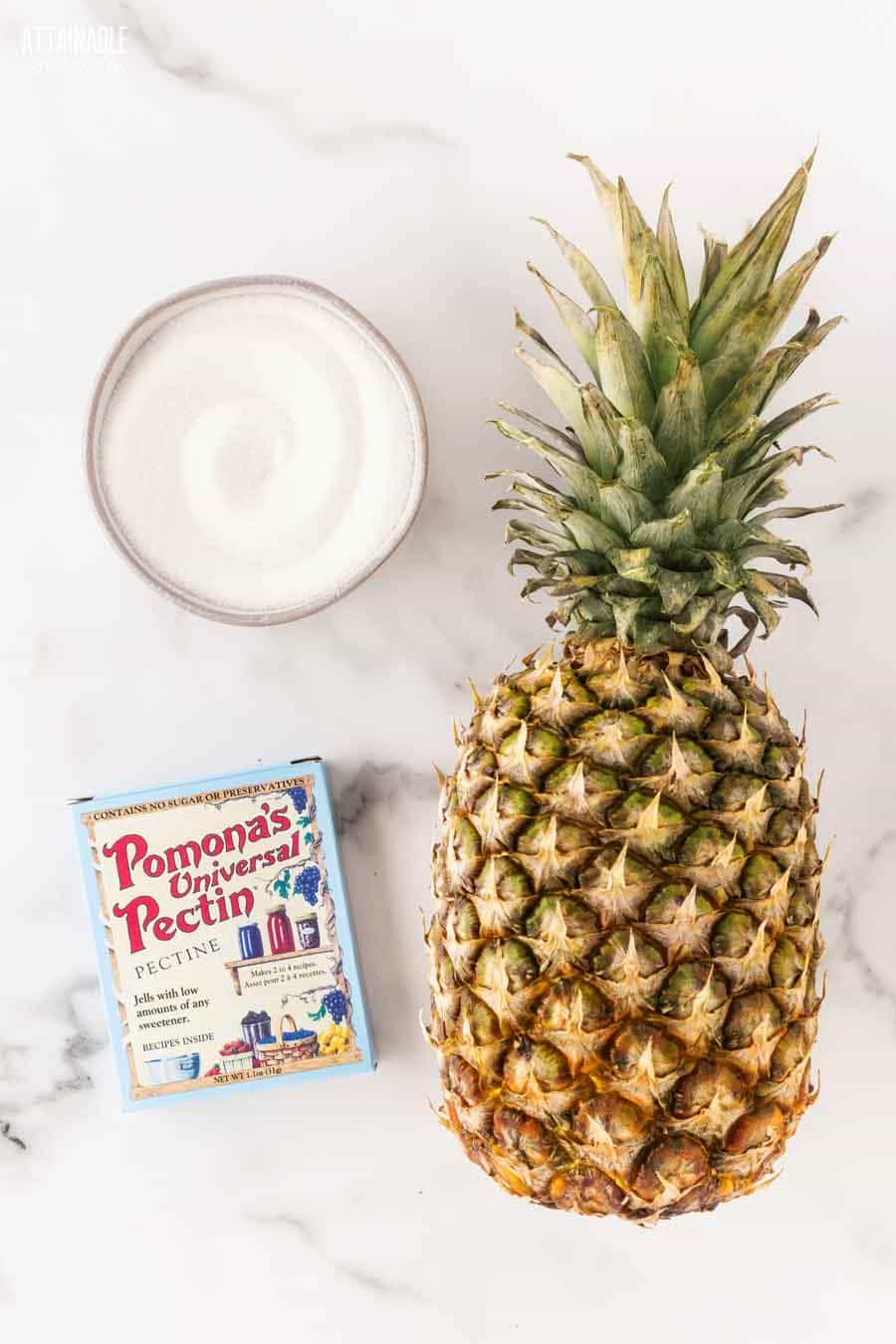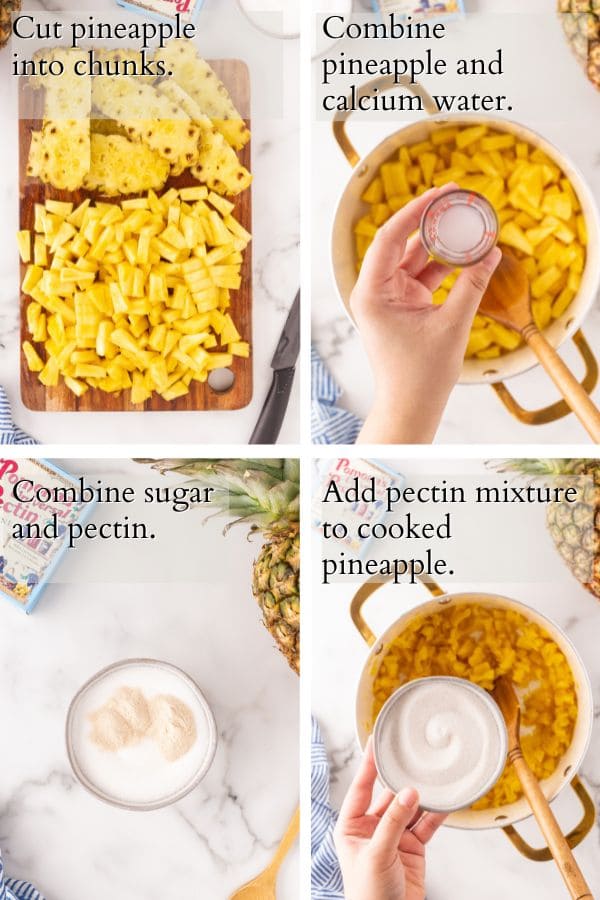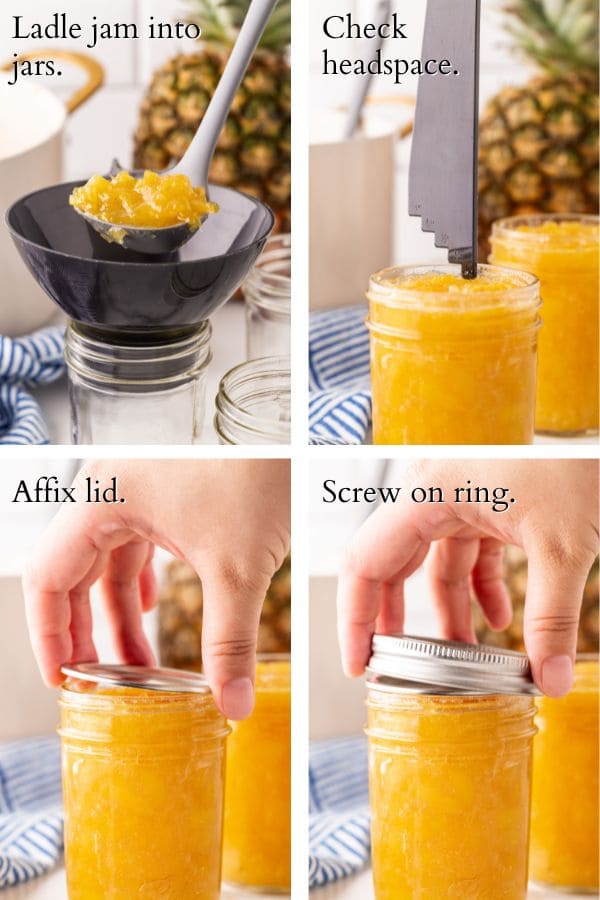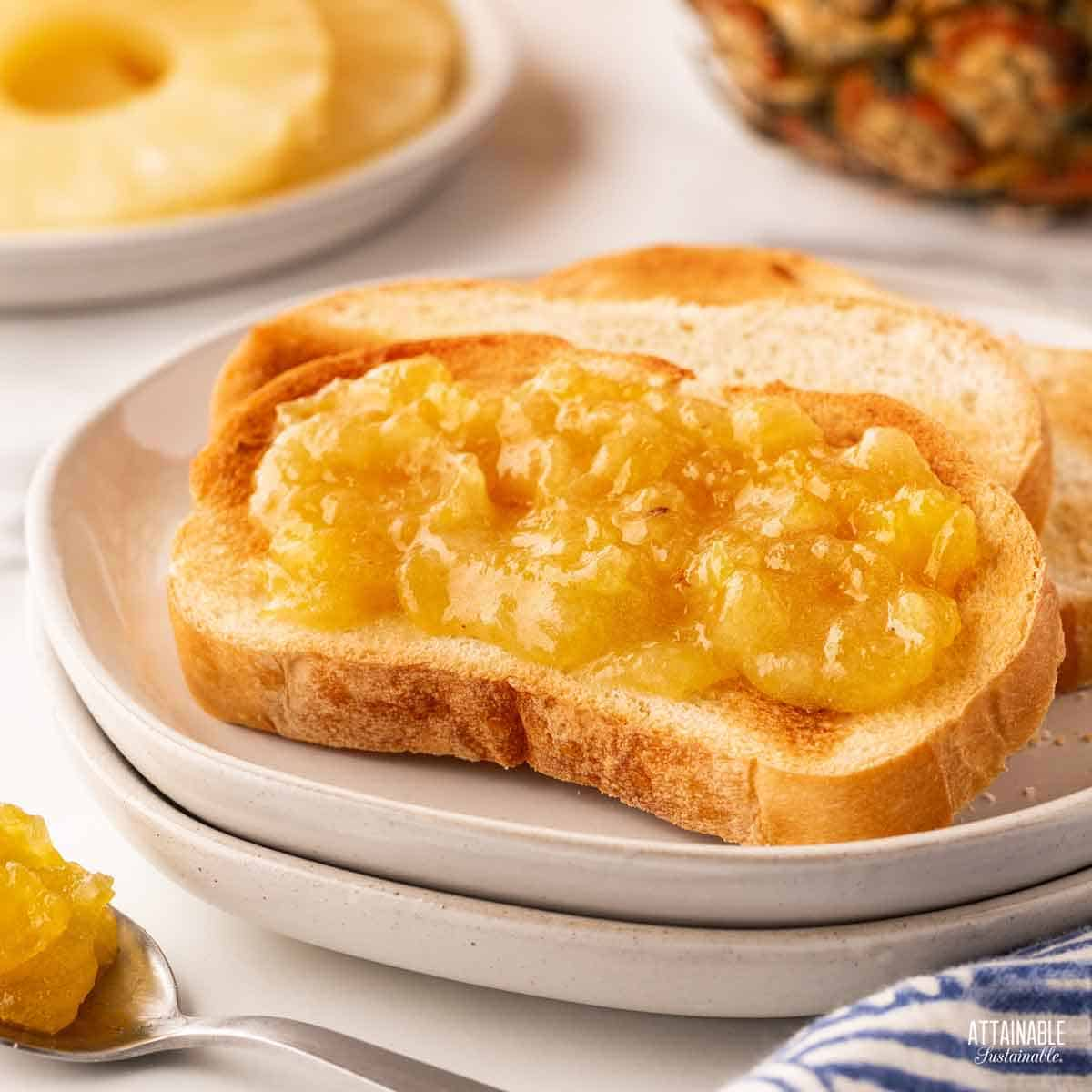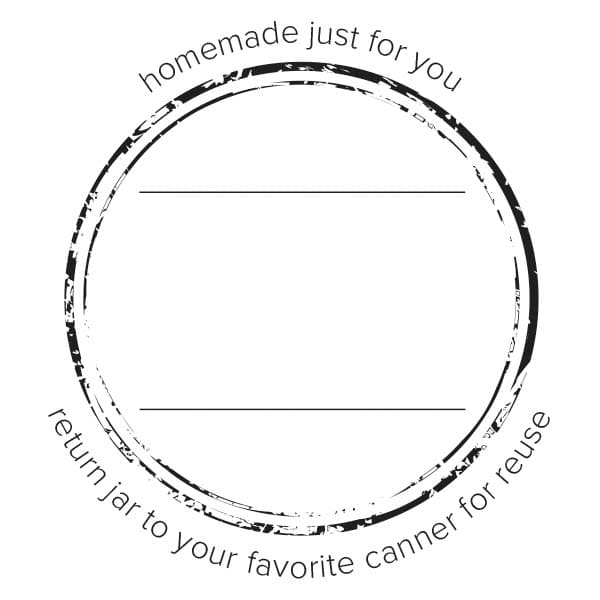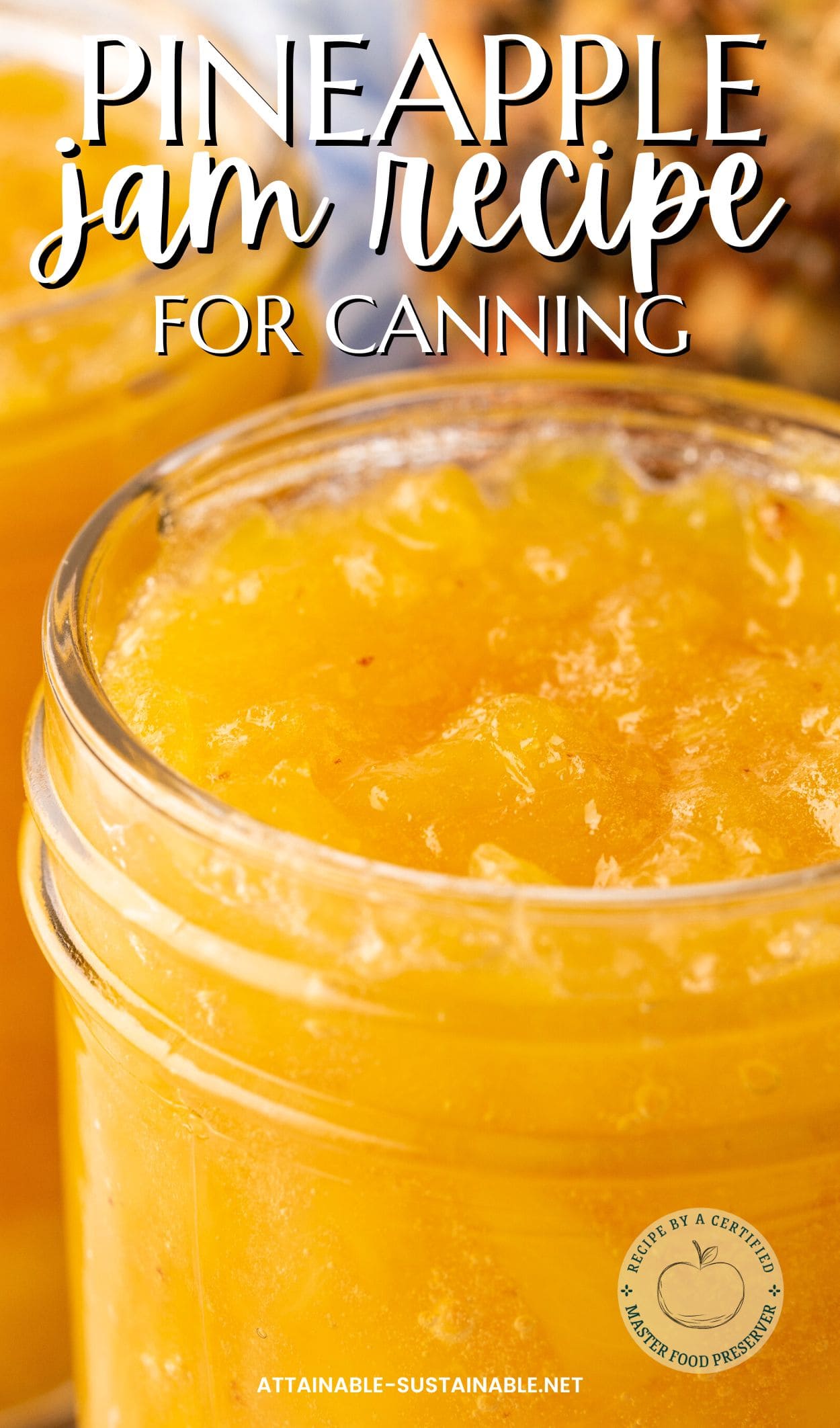Ready to make your own pineapple jam? This recipe transforms a favorite tropical fruit into a shelf stable jam that is more delicious than the store-bought option.
This easy pineapple jam recipe calls for just a few ingredients and can be ready to serve in under an hour. Make it and refrigerate it for immediate use, or use a water bath canning method to make a shelf stable product. I like to make this in small jars to use as hostess gifts.
Ingredients
Pineapple — Look for fruit with yellowing skin, which indicates that the fruit is ripe. Another indicator is fragrance. Can you smell the aroma of pineapple? If you have a pineapple that is close but not quite there, let it sit on the counter for a day or two, where it will continue to ripen. (Learn how to grow your own pineapple here.)
Sugar — Sugar is required for the setting of the jam. Using Pomona’s Universal Pectin allows us to use less sugar, making a mildly sweet pineapple jam. Use your favorite brand of granulated white sugar. I prefer organic. You can safely use brown sugar, but it will alter both the flavor and color.
Pectin – This recipe is made using Pomona’s Universal Pectin. This is the only pectin I use anymore as it allows me to use much less sweetener. The standard pectin brands use an obscene amount of sugar in my opinion, often requiring equal amounts of sugar and fruit! This product uses a low methoxyl method and calls for using two different ingredients, which are included in the box: pectin (the large packet) and calcium powder (the small packet). The dry pectin is mixed with the sweetener before being added to the fruit. The calcium water is added directly to the fruit.
5 Easy Steps to Transform Your Pantry!
Ready to switch from store bought to homemade? Let me help you make some changes! Grab my FREE five-part guide to getting started.
Be sure to save the pineapple skins to make this delicious pineapple tepache fermented drink.
Fresh pineapples can be a little bit daunting, especially if you’ve never cut one open before. Start by cutting off the green crown and the bottom of the pineapple. Set the crown aside; plant it to grow your own pineapple!
Set the pineapple on one of the cut edges and use a sharp knife to trim just under the rough skin, from top to bottom. Repeat until all of the pineapple peel is removed.
If there are any hard “eyes” remaining, trim those away.
Cut pineapple vertically into quarters. Trim off the hard core and discard. Dice the remaining pieces of pineapple according to how chunky you like your jam.
You can pulse the pineapple in a food processor for a finer jam, or simply hand chop it into 1/4″-1/2″ pieces.
The Cooking Process
Combine the prepared pineapple and the calcium water in a large saucepan and bring to simmer. Cook until the pineapple softens and becomes somewhat transparent, stirring frequently to prevent the fruit from sticking to the bottom of the pan.
While that’s cooking, mix the sugar and dry pectin together thoroughly.
Once pineapple is sufficiently cooked, add the sugar mixture and cook for two minutes more.
The jam is ready to eat at this point. You can simply transfer to clean jars and make it a refrigerator jam (it will last in the fridge for several weeks). For a shelf stable jam, you’ll need to follow safe canning guidelines as outlined below.
Canning Jam
You’ll need special some special equipment – canning jars, lids, and rings (read more about canning supplies here) – to make this fresh pineapple jam shelf-stable, but the process isn’t difficult.
Use quarter-pint jars, half-pint jars, or pint jars for this recipe.
Once filled, you’ll process jars in a boiling water bath. What this means is you’ll put the filled and sealed jars of jam into boiling water and heat them for ten minutes. This assures that the jars will seal well.
You might be able to use a large pot, rather than a special water bath canner.
Place hot jars on a countertop lined with a clean towel and allow to cool fully. As they cool, you’ll hear the little “tink” sound of the jars sealing. Store any unsealed jars in the fridge and use those first. (This is unusual, but it does happen once in awhile.)
Remove the ring from each sealed jar, rinse to remove any jam residue, and store (without the ring) in a cool place, such as the pantry.
Here’s a more detailed look at canning jam and jelly and a collection of even more jam recipes!
🍅 Safety First!
Canning is an excellent way to preserve food for the pantry, but there are some important safety considerations to keep in mind. The recipes on this site have been made following safe canning procedures by a certified Master Food Preserver.
- Know the difference between water bath canning and pressure canning. Low acid items must be pressure canned for safety.
- Altering ingredients may change the recipe’s pH, posing a safety issue.
- Use the proper jars and lids. Never reuse lids, with the exception of the Tattler or Harvest Right hard plastic lids that are intended for such a purpose.
- For more on canning equipment, please go here.
- Want to learn more? The National Center for Home Food Preservation is the go-to resource for safe canning information.
Using this Jam
The obvious way to enjoy this sweet spread is on your morning toast. Beyond that, though?
- Spoon some over vanilla ice cream.
- Pair with cream cheese and crackers for a sweet and savory appetizer.
- Baste it on grilled meats and veggies.
FAQs
Do I need to use sterilized jars?
According to the National Center for Home Food Preservation, canning jars only need to be sterilized if they are processed for fewer than 10 minutes. Because this recipe calls for a process time of ten minutes, you do not need to sterilize the jars – the canning process is sufficient. DO start with clean jars, though!
How long does homemade pineapple jam last?
For best quality, homemade jam should be used within a year or so, though as long as the seal remains intact and the jam was prepared properly, the product inside the glass jar will be safe to eat.
Can I use canned pineapple?
You absolutely can. Chop chunks of pineapple into smaller pieces. Crushed pineapple can be used without any extra chopping.
What’s the difference between pineapple jam and pineapple preserves?
Fruit preserves are similar to jam, but generally have larger pieces of fruit or whole fruit, in the case of berries.
★ Did you love this recipe? Be sure to give it a star rating below! ★
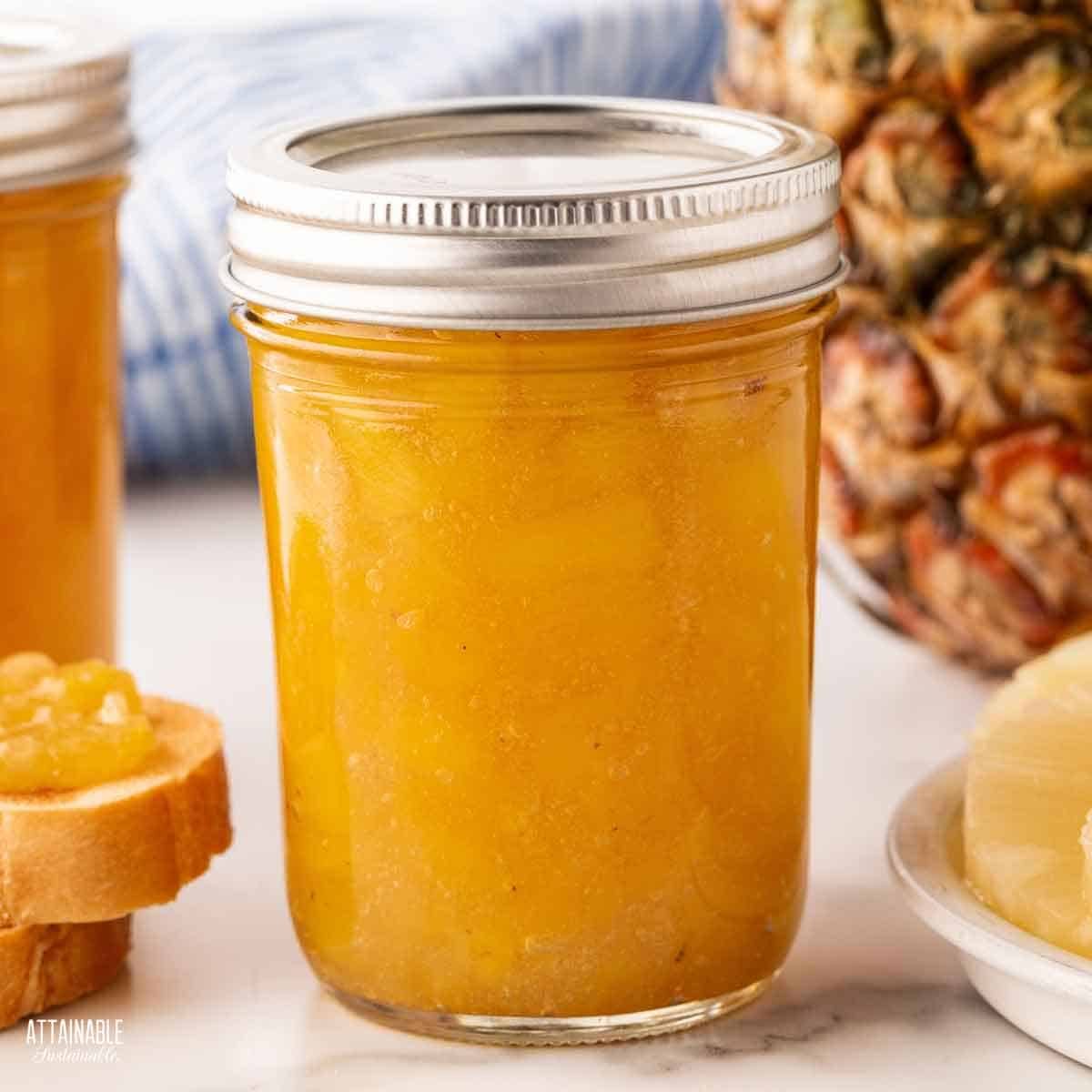
Pineapple Jam Recipe
Ingredients
- 4 cups pineapple peeled, cored, and chopped
- 2 teaspoons calcium water from Pomona's Pectin package
- ¾ - 1 cup granulated organic cane sugar
- 2 teaspoons pectin from Pomona's Pectin package
Instructions
PREP FOR CANNING
- Fill a canning pot with water, set the lid in place, and heat on high heat until boiling. It can take awhile for the water to come to a boil, so get it started before you begin making the jam.
- Gather the jars you'll use and wash in hot soapy water. Make sure each is free of nicks in the rim, which could impede sealing.
- Bring a small pot of water to a simmer and turn off the heat. Place lids and rings into the water and leave them there until you're ready to screw them onto the filled jars.
MAKE THE CALCIUM WATER
- Combine ½ teaspoon calcium powder (from the small packet in the box of Pomona’s pectin) with ½ cup water in a small jar.
- Screw on a lid and shake until well-combined. You'll have more than you need for this recipe.
- Store the excess in the refrigerator for use in making additional jam or jelly recipes.
MAKE THE PINEAPPLE JAM
- In a large saucepan, combine chopped pineapple and calcium water. Over medium heat, bring to simmer, stirring frequently. Cook until the pineapple softens and takes on some translucency, about 20-25 minutes. Use a potato masher to break up the pineapple chunks.4 cups pineapple, 2 teaspoons calcium water
- Meanwhile, mix the sugar and pectin together in a small bowl. When the pineapple mixture is adequately cooked, add the sugar/pectin mixture to simmering fruit and stir until completely dissolved, about two minutes.3/4 - 1 cup granulated organic cane sugar, 2 teaspoons pectin
CANNING THE JAM
- Ladle hot jam into quarter-pint, half-pint, or pint sized jars, leaving 1/4" head space. A canning funnel makes this easy.
- Wipe jar rims to remove any jam that may have spilled. A clean rim is essential to a good seal.
- Set jar lids in place. Screw bands on finger tight.
- Use a jar lifter to gently submerge jars into hot water in the canning pot. Water should cover the top of the jars by an inch. The water will cool somewhat in reaction to the addition of the jars. Return the water to a full rolling boil and then set the timer.
- Process for 10 minutes 0-1,000 feet altitude; add an additional minute for every additional 1,000 feet in elevation.
- Remove jars from water using the jar lifter and transfer to a solid, towel-covered surface. Allow to cool for 24 hours.
- Check seals. Lids should be solid and pulled down tight. (if they flex and pop, the jar didn’t seal; put unsealed jars in the refrigerator and use those first).
- Remove rings and wash outsides of jars. Store in a cool, dry place.
Notes
- Adapted from https://pomonapectin.com.
Nutrition

